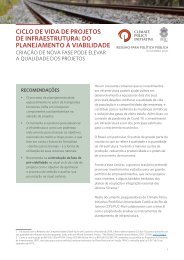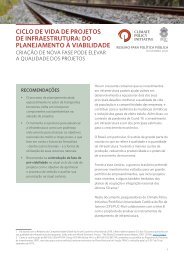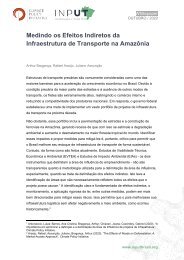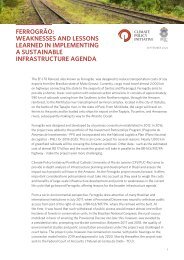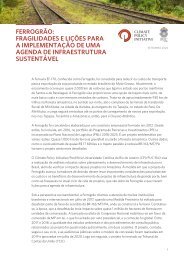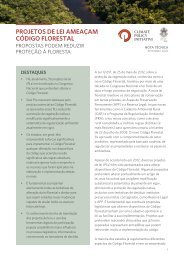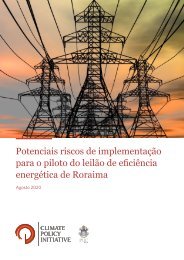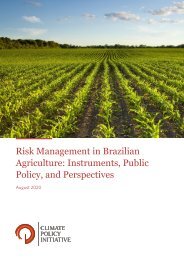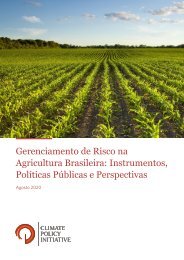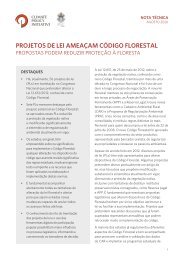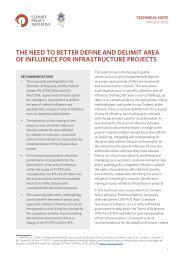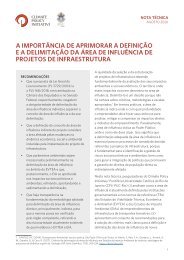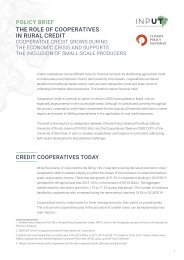Cattle-ranching-intensification-as-a-key-role-on-sustainable-agriculture-expansion-in-Brazil_Agroicone_INPUT
Create successful ePaper yourself
Turn your PDF publications into a flip-book with our unique Google optimized e-Paper software.
CATTLE RANCHING<br />
CONTEXT<br />
<str<strong>on</strong>g>Cattle</str<strong>on</strong>g> <str<strong>on</strong>g>ranch<strong>in</strong>g</str<strong>on</strong>g> <str<strong>on</strong>g><strong>in</strong>tensificati<strong>on</strong></str<strong>on</strong>g><br />
<str<strong>on</strong>g>as</str<strong>on</strong>g> a <str<strong>on</strong>g>key</str<strong>on</strong>g> <str<strong>on</strong>g>role</str<strong>on</strong>g> <strong>on</strong> <strong>susta<strong>in</strong>able</strong><br />
<strong>agriculture</strong> expansi<strong>on</strong> <strong>in</strong> <strong>Brazil</strong><br />
In <strong>Brazil</strong>, agribus<strong>in</strong>ess is a significant activity<br />
with great importance <strong>in</strong> GDP, employment,<br />
<strong>in</strong>come and <strong>in</strong>flows of foreign currencies<br />
through exports. More specifically, beef sector<br />
h<str<strong>on</strong>g>as</str<strong>on</strong>g> great relevance <strong>in</strong> the country’s exports, <str<strong>on</strong>g>as</str<strong>on</strong>g><br />
well <str<strong>on</strong>g>as</str<strong>on</strong>g> <strong>in</strong> the domestic market.<br />
In 2014, accord<strong>in</strong>g to <strong>Brazil</strong>ian Associati<strong>on</strong><br />
of Beef Exporters - ABIEC (2015), beef<br />
producti<strong>on</strong> reached 10.1 milli<strong>on</strong> t<strong>on</strong>s of carc<str<strong>on</strong>g>as</str<strong>on</strong>g>s<br />
weight equivalent (CWE), out of which 2.1<br />
milli<strong>on</strong> w<str<strong>on</strong>g>as</str<strong>on</strong>g> exported, followed by technological<br />
improvements <strong>in</strong> cattle <str<strong>on</strong>g>ranch<strong>in</strong>g</str<strong>on</strong>g>, which have<br />
allowed producti<strong>on</strong> to <strong>in</strong>cre<str<strong>on</strong>g>as</str<strong>on</strong>g>e us<strong>in</strong>g a smaller<br />
area, displaced by other activities.<br />
Historically, the evoluti<strong>on</strong> of nati<strong>on</strong>al cattle<br />
<str<strong>on</strong>g>ranch<strong>in</strong>g</str<strong>on</strong>g> h<str<strong>on</strong>g>as</str<strong>on</strong>g> followed territorial occupati<strong>on</strong>,<br />
expand<strong>in</strong>g producti<strong>on</strong> and promot<strong>in</strong>g ec<strong>on</strong>omic<br />
development <strong>in</strong> several <strong>Brazil</strong>ian regi<strong>on</strong>s. It is<br />
estimated that from 2010 to 2013, the are<str<strong>on</strong>g>as</str<strong>on</strong>g><br />
allocated to p<str<strong>on</strong>g>as</str<strong>on</strong>g>tures occupied 19% to 23% of the<br />
entire nati<strong>on</strong>al territory, which represents between<br />
164 to 198 milli<strong>on</strong> hectares, depend<strong>in</strong>g <strong>on</strong> the<br />
source c<strong>on</strong>sidered.<br />
Agroic<strong>on</strong>e estimates po<strong>in</strong>t to a reducti<strong>on</strong> <strong>in</strong><br />
p<str<strong>on</strong>g>as</str<strong>on</strong>g>ture are<str<strong>on</strong>g>as</str<strong>on</strong>g> by 4.1 milli<strong>on</strong> hectares between<br />
1996 and 2013 <strong>in</strong> <strong>Brazil</strong>, however p<str<strong>on</strong>g>as</str<strong>on</strong>g>ture are<str<strong>on</strong>g>as</str<strong>on</strong>g><br />
<strong>in</strong> some regi<strong>on</strong>s of the country have <strong>in</strong>cre<str<strong>on</strong>g>as</str<strong>on</strong>g>ed,<br />
especially <strong>in</strong> the agricultural fr<strong>on</strong>tier regi<strong>on</strong>s (such<br />
<str<strong>on</strong>g>as</str<strong>on</strong>g> <strong>in</strong> the North regi<strong>on</strong>) and, hitherto covered by<br />
native vegetati<strong>on</strong>.<br />
C<strong>on</strong>sider<strong>in</strong>g the importance of agribus<strong>in</strong>ess<br />
<strong>in</strong> <strong>Brazil</strong> and recent efforts to reduce nati<strong>on</strong>al<br />
deforestati<strong>on</strong>, it is estimated the impacts of<br />
Forest Code (Law nº 12.651 of May, 2012)<br />
implementati<strong>on</strong> and deforestati<strong>on</strong> reducti<strong>on</strong>,<br />
c<strong>on</strong>sider<strong>in</strong>g l<strong>on</strong>g term expansi<strong>on</strong> of the ma<strong>in</strong><br />
agricultural activities <strong>in</strong> <strong>Brazil</strong>.<br />
The Forest Code and the reducti<strong>on</strong> of<br />
deforestati<strong>on</strong> are unique opportunities for<br />
<strong>Brazil</strong> to comb<strong>in</strong>e producti<strong>on</strong> and envir<strong>on</strong>mental<br />
c<strong>on</strong>servati<strong>on</strong>, result<strong>in</strong>g <strong>in</strong> several ec<strong>on</strong>omic, social<br />
and envir<strong>on</strong>mental benefits. The beef supply<br />
cha<strong>in</strong> is at the forefr<strong>on</strong>t of these issues, especially<br />
c<strong>on</strong>sider<strong>in</strong>g the <strong>on</strong>go<strong>in</strong>g acti<strong>on</strong>s and the large<br />
scale producti<strong>on</strong> <str<strong>on</strong>g><strong>in</strong>tensificati<strong>on</strong></str<strong>on</strong>g> opportunity,<br />
which is practically <strong>in</strong>existent <strong>in</strong> other sectors.<br />
Mato Grosso state, <str<strong>on</strong>g>as</str<strong>on</strong>g> an example explored <strong>in</strong> this<br />
summary, launched the PCI – Produce, C<strong>on</strong>serve<br />
and Include program at COP 21 <strong>in</strong> December<br />
2015, be<strong>in</strong>g <strong>in</strong> the forefr<strong>on</strong>t of a l<strong>on</strong>g-term goal to<br />
<strong>susta<strong>in</strong>able</strong> <strong>agriculture</strong> development.<br />
This document aims to present a summary of<br />
three studies, result<strong>in</strong>g <strong>in</strong> the follow<strong>in</strong>g <str<strong>on</strong>g>key</str<strong>on</strong>g> messages:<br />
a) cattle <str<strong>on</strong>g>ranch<strong>in</strong>g</str<strong>on</strong>g> <str<strong>on</strong>g><strong>in</strong>tensificati<strong>on</strong></str<strong>on</strong>g> is <str<strong>on</strong>g>key</str<strong>on</strong>g><br />
to promote <strong>agriculture</strong> expansi<strong>on</strong>,<br />
deforestati<strong>on</strong> reducti<strong>on</strong> and Forest Code<br />
implementati<strong>on</strong> <strong>in</strong> the l<strong>on</strong>g term;<br />
b) cattle <str<strong>on</strong>g><strong>in</strong>tensificati<strong>on</strong></str<strong>on</strong>g> is ec<strong>on</strong>omically viable,<br />
but m<strong>in</strong>imum scale is needed;<br />
c) expand<strong>in</strong>g cattle activity over natural<br />
vegetati<strong>on</strong> is ec<strong>on</strong>omically fe<str<strong>on</strong>g>as</str<strong>on</strong>g>ible due to<br />
land price appreciati<strong>on</strong>;<br />
d) low productivity p<str<strong>on</strong>g>as</str<strong>on</strong>g>turelands can<br />
be displaced by crops and vegetati<strong>on</strong><br />
restorati<strong>on</strong> <strong>in</strong> order to optimize returns and<br />
for envir<strong>on</strong>mental compliance (Mato Grosso<br />
c<str<strong>on</strong>g>as</str<strong>on</strong>g>e studies);<br />
e) <strong>in</strong>vestments should be oriented to <strong>in</strong>tensify<br />
cattle <str<strong>on</strong>g>ranch<strong>in</strong>g</str<strong>on</strong>g> activity located <strong>in</strong> producti<strong>on</strong><br />
clusters aim<strong>in</strong>g at <strong>susta<strong>in</strong>able</strong> orig<strong>in</strong>ati<strong>on</strong>.<br />
7



